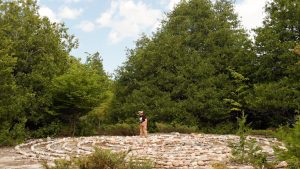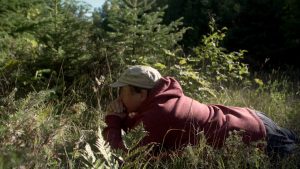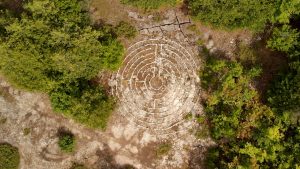7 Next Steps
As you embark on the journey of integrating nature connection into your teaching practice, there are several key steps to continue planting seeds of growth and understanding in your students’ minds. In this section, we propose some steps to further emphasize the importance of reconnecting with the living world while challenging colonial perspectives.
Continuing to Plant the Seeds
Embrace Connection to Life and Experience-Based Information Gathering:
Encourage students to observe and interact with the natural world, fostering a sense of animism where all elements of the environment are seen as alive and interconnected. Teach them to gather information through keen observation and by utilizing all their senses. Promote sensory engagement with the environment and encourage students to listen, feel, and observe deeply.
Engage with Knowledge-keepers:
Integrate the knowledge of knowledge-keepers—those who carry traditional Indigenous ecological knowledge—and emphasize learning from their experiences and teachings. Encourage authentic and respectful relationship building with Indigenous community members.
Build Relationships with the Other-than-humans:
Foster a sense of relationship-building with the other-than-human beings in the natural world—plants, animals, rocks, and water—encouraging students to see themselves as part of a larger ecological community.
Recognize the Land as the First Teacher:
Emphasize the Indigenous concept of the living world as the first teacher, encouraging students to learn directly from the environment and understand its lessons through immersive experiences. As you spend time outdoors with students, pay attention to things in nature that present themselves – such as a dead animal, a blossoming flower, or fresh mushrooms in an area – and focus your learning and discussion on what you can immediately observe. Ask questions that inspire each other to pay closer attention to the surroundings.
Challenge Colonial Perspectives:
Actively engage students in critical thinking about colonial perspectives and the impact of colonization on Indigenous lands and cultures. Encourage them to question and challenge these viewpoints by reflecting on historical names of places (i.e., what were cities/regions called before their colonial names), common names for animal and plant species (e.g., Queen Anne’s lace, Cooper’s hawk – what names did these species have before), and current geographical and political boundaries (i.e., how did Indigenous people define boundaries before colonial maps). Promoting new perspectives help students foster a more inclusive and respectful understanding of history and the environment.
Incorporate Wonder and Awe:
Instill a sense of wonder and awe in your teaching, helping students to appreciate the beauty and complexity of the natural world. Inspiring these feelings and emotions will look different between unique instructors and groups of students. The natural environment you can work with will emphasize special features within itself if we are careful enough to observe. Sharing what brings us amazement can inspire deeper connections and a lifelong commitment to environmental awareness.
Integrate Songs and Stories:
Use songs and stories to convey the wisdom of nature and its inhabitants. These cultural expressions can be powerful tools for teaching and can help students internalize the nature connection lessons in a memorable and meaningful way.
Doing Your Own Work to Reconnect
As an instructor, you are engaging in your own journey of reconnection with the living world. This personal work will enhance your ability to teach nature connection authentically and effectively. Challenge your own perspectives, seek out opportunities to learn from the living world and your community, build relationships with knowledge-keepers and other educators, and cultivate a practice of wonder and awe in your daily life.
Advocate for Institutional Change
An emerging topic throughout our interviews was the need for institutional support and policy changes within educational institutions to embed decolonial pedagogy into the curriculum and create inclusive learning environments. The educators we spoke with had specific requirements of institutions to value the impacts of and opportunities for nature connection, recognizing that this will vary depending on the needs and context of each place.
Half the participants identified a need for commitment to knowledge building from institutions to support learning that focuses on widening perspectives in our relationships with ecology. They also expressed a need for permanent positions for Indigenous educators who are hired as knowledge holders that carry land-based teachings and who can support development of decolonial frameworks. Part of having Indigenous knowledge holders accessible to education programs includes important partnership development. Most participants also felt that in a broader sense, the way we think about education needs to be shifted to implement nature-based ways of teaching and learning more broadly. By extension, access to land, workplace wellness professional development, and course design autonomy were provided as examples of institutional change.
“But I think the question is, how do we move the universities, or whatever institution we’re in, to be able to be a bit more open? And so, I think that that’s where the real challenge comes in. It’s not about necessarily convincing people that this is important. It’s about actually doing the work to make those changes within institutions.” – Participant H
Learning More
To deepen your understanding and practice of nature connection, consider exploring the following resources:
Academic Research:
Stay informed about recent research in nature connection education and related fields. Scholarly articles and studies can provide valuable insights and evidence-based practices.
Resource/Reference Books:
Build a library of essential readings on nature connection, Indigenous knowledge, and ecological education. These books can serve as ongoing references and sources of inspiration.
Contemplative Writings:
Engage with contemplative writings that explore the spiritual and philosophical dimensions of connecting with the living world. These texts can offer profound reflections and guidance.
Classes and Workshops:
Participate in classes or workshops focused on nature education and related topics. These learning experiences can provide practical skills and deepen your understanding.
Find Mentors:
Seek out mentors who have expertise in nature education and related areas. Their guidance and support can be invaluable as you develop your teaching practice.
Mentor Others:
As you gain experience, consider mentoring other instructors and students. Sharing your knowledge and insights can help spread the impact of this important work and establish a greater community of educators.




Feedback/Errata